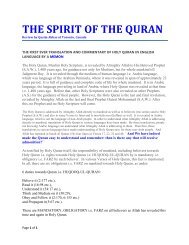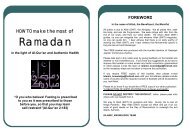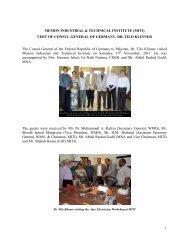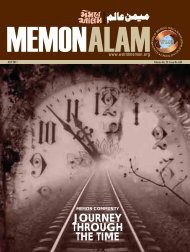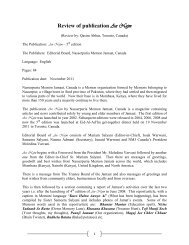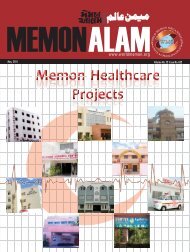August 2011 Final Pages.indd - World Memon Organization ...
August 2011 Final Pages.indd - World Memon Organization ...
August 2011 Final Pages.indd - World Memon Organization ...
Create successful ePaper yourself
Turn your PDF publications into a flip-book with our unique Google optimized e-Paper software.
MEDICAL SCIENCE<br />
Better help for<br />
back and neck pain<br />
Back pain and neck pain are two of the<br />
most common problems affecting adults of<br />
all ages. While most painful episodes are<br />
only temporary, those afflicted with chronic<br />
conditions endure long term suffering that<br />
can deal a serious blow to the quality of<br />
everyday life. As part of this issue’s special<br />
focus on bones and joints, Better Health<br />
turned to Dr. Verapan Kuansongtham,<br />
an orthopedic surgeon and Director of<br />
Bumrungrad’s Spine Specialists Centre. For<br />
an expert look at how advances in treating<br />
chronic back and neck pain are helping<br />
patients enjoy healthier, less painful lives.<br />
Chronic pain<br />
Pain that persists for at least three months<br />
without responding to treatment usually<br />
medication and/or physical therapy is classified<br />
as chronic. “Back and neck pain are<br />
very common in adults,” Dr. Verapan says.<br />
“Most cases aren’t serious and are often<br />
caused by bad posture habits or heavy physical<br />
activity that strains muscles and causes<br />
temporary pain.”<br />
Patients can usually conquer an episode of<br />
back or neck pain with a combination of better<br />
posture, more rest and anti-inflammatory<br />
pain medication. However, areas such as the<br />
arms or legs, patients should consult their<br />
doctor, as these symptoms may be a sign of a<br />
more serious nervous system condition.<br />
Internal and external<br />
There are both internal and external causes<br />
32<br />
for back and neck pain. Possible internal<br />
causes include spinal conditions such as<br />
herniated discs, spondylitis, spondylolisthesis,<br />
scoliosis and spinal metastasis; common<br />
external factors include poor body posture,<br />
injuries and medical conditions arising from<br />
physical activities.<br />
Poor posture - sitting in the same position<br />
for a prolonged period, sitting without<br />
proper back support, or slouching with<br />
the back or neck straining forward, among<br />
others - puts excessive pressure on back and<br />
neck bones. When these bad habits continue<br />
over many months or years, bones begin to<br />
degenerate, resulting in chronic back and<br />
neck pain.<br />
While car accidents and sporting mishaps<br />
can result in painful back and neck injuries,<br />
they account for a relatively small percentage<br />
of back and neck pain cases. In fact,<br />
while an accident would seem to be the<br />
obvious cause for a patient’s painful symptoms,<br />
closer examination often uncovers a<br />
pre-existing problem like bone degeneration<br />
whose symptoms are triggered by an<br />
accident.<br />
Diagnosis critical<br />
Making an accurate, precise diagnosis is<br />
the critical first step in successfully treating<br />
painful back and neck problems. “When<br />
a patient comes for evaluation, the doctor<br />
usually begins the diagnostic process by asking<br />
about the patient’s medical history, “Dr.<br />
Verapan explains. “This is an especially<br />
important first step; a precise diagnosis for<br />
a patient who has been suffering for a very<br />
long time perhaps several years usually<br />
warrants more than just a few minutes time<br />
to fully understand the exact source of the<br />
problem.”<br />
It’s not unusual for chronic conditions to<br />
persist when patients aren’t properly diagnosed<br />
and the real cause is left unidentified.<br />
Some may be examined only by touch, and<br />
if the pain hasn’t spread to other parts of<br />
the body, and treatment they’re prescribed is<br />
unlikely to relieve their symptoms. With the<br />
pain still present, patients can become more<br />
desperate and change doctors in search of<br />
relief. “That makes a thorough, detailed<br />
medical history vital to proper diagnosis,”<br />
says Dr. Verapan. “Doctors also have a<br />
range of tests such as X-ray imaging and<br />
MRI scans to help identify the source of<br />
the problem so that the proper treatment<br />
strategy can be implemented.”<br />
Managing pain<br />
The next step is to determine the optimal<br />
course of treatment usually a combination<br />
of medication, physiotherapy<br />
and rest. According to Dr. Verapan,<br />
there are many treatment options to<br />
be considered. But the following three<br />
procedures are among the best options<br />
as, in addition to successfully relieving<br />
pain. They have also been shown to play<br />
a major role in boosting patient’s everyday<br />
quality of life.<br />
MEMON ALAM AUGUST <strong>2011</strong>



